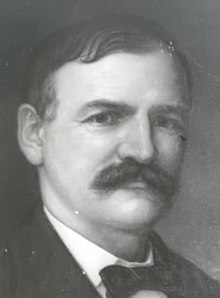Robert Emory Pattison
Robert Emory Pattison (born December 8, 1850 in Quantico , Wicomico County , Maryland , † August 1, 1904 ) was an American politician ( Democratic Party ) and from 1883 to 1887 the 19th and between 1891 and 1895 the 21st governor of Pennsylvania .
Early years and political advancement
At the age of five, Robert Pattison moved with his parents to Philadelphia , Pennsylvania. There he attended the local schools. After studying law with Lewis Cassidy , the leader of the Democratic Party in Philadelphia, and his admission to the bar in 1871, Pattison began to work in the profession.
In 1878 he became Controller of the City of Philadelphia. In this position he was very successful. This made him so popular that in 1882 his party nominated him as a candidate for the upcoming gubernatorial election, despite his relatively young age of 32. His subsequent election victory was also the first Democrat victory in gubernatorial elections in Pennsylvania since 1858, when William F. Packer was elected to that office.
Governor of Pennsylvania
Robert Pattison began his first four-year term on January 16, 1883. In his administration, his friend and former law teacher Cassidy became Attorney General . Pattison, as governor, campaigned for an economical budget policy. He fought corruption and nepotism in his country. But the appointment of the Minister of Justice made an exception. In terms of social policy, the governor was in favor of a fair division of power between companies and workers, or between capital and the unions. He also came out against the monopoly of railroad companies. Due to the constitution of 1874, the governor was not allowed to serve two consecutive terms. Therefore, on January 18, 1887, he had to hand over his office to his elected successor, James Beaver .
Pattison then became president of Chestnut Street National Bank . He was also the head of the Pacific Railroad Commission , a federal commission to oversee this railroad company. In 1890 he managed to be re-elected to the office of governor. His second term began on January 20, 1891. The focus of the new government was on electoral reform, the fight against the waste of public money and a fairer distribution of the tax burden. In 1892 there was a violent steel workers' strike, during which Pattison deployed the National Guard to maintain order.
Another résumé
Due to the aforementioned constitutional clause, Pattison was not allowed to run for re-election in 1894. Therefore, he resigned from his office on January 15, 1895 and began working as a lawyer. Pattison would remain the last Democratic governor of Pennsylvania until 1934. He ran unsuccessfully for the office of mayor of Philadelphia. In 1896 he was under discussion as a presidential candidate for the Democratic Party, but could not prevail against William Jennings Bryan at the federal party conference. In 1902 he ran again for governor of Pennsylvania. This time he lost to Samuel Pennypacker . Robert Pattison died two years later at the age of 54.
literature
- Robert Sobel and John Raimo (Eds.): Biographical Directory of the Governors of the United States, 1789–1978. Volume 4, Meckler Books, Westport, 1978. 4 volumes.
Web links
- Robert Emory Pattison in the database of the National Governors Association (English)
- Robert Emory Pattison ( April 17, 2008 memento in the Internet Archive ) in the Pennsylvania Historical and Museum Commission database
- Robert Emory Pattison in the database of Find a Grave (English)
| personal data | |
|---|---|
| SURNAME | Pattison, Robert Emory |
| BRIEF DESCRIPTION | American politician |
| DATE OF BIRTH | December 8, 1850 |
| PLACE OF BIRTH | Quantico , Maryland |
| DATE OF DEATH | August 1, 1904 |

